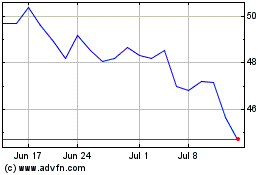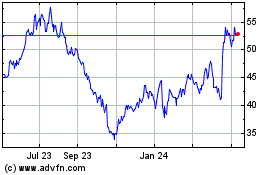Corporate Bond Gauge Signals Dwindling Economic Risk -- Update
April 22 2021 - 2:45PM
Dow Jones News
By Sam Goldfarb
A key measure of the perceived risk in low-rated corporate bonds
is hovering around its lowest level in more than a decade,
highlighting investors' mounting confidence in the economic
outlook.
The average extra yield, or spread, investors demand to hold
speculative-grade corporate bonds over U.S. Treasurys dropped below
3 percentage points this month to as low as 2.90 percentage points
for the first time since 2007, when it set a record of 2.33
percentage points, according to Bloomberg Barclays data.
Yields on low-rated corporate bonds already hit a record low of
3.89% in February. That data point is especially important for
businesses, because it signals how cheaply they can borrow when
they issue new bonds. Companies including Charter Communications
Inc. and United Airlines Holdings Inc. have issued a total of
$186.1 billion of speculative-grade bonds this year through
Wednesday, the highest over that period on record, according to
LCD, a unit of S&P Global Market Intelligence.
The spread relative to Treasurys, however, is arguably an even
better measure of investors' outlook for the economy, since it
shows how much investors feel they need to be compensated for the
risk that companies may default on their debt.
The narrow speculative-grade bond spreads indicate debt
investors think that the economic environment for businesses over
the next several years could be better than at any time since the
2008-2009 financial crisis -- a striking development after many
feared a severe, long-lasting economic downturn just last year.
As of Wednesday, the average speculative-grade bond spread was
2.98 percentage points. That was slightly higher than earlier in
the month but still down from 3.60 percentage points at the end of
last year and 4.42 percentage points on Nov. 6, the last full
trading session before Pfizer Inc. announced highly encouraging
results from its coronavirus-vaccine trial.
Investors and analysts say that two major factors have been
responsible for that decline. One is improving economic data,
especially consumer spending on goods, which analysts closely link
to the two economic relief measures that Congress passed in recent
months. The other is optimism for a broader economic rebound later
in the year, as people feel more comfortable spending money on
services, such as airline travel and restaurant dining.
Despite the setback last week when U.S. health authorities
recommended a pause in the use of Johnson & Johnson's Covid-19
vaccine, many investors and analysts are still pleased with the
pace of vaccinations in the U.S. They note that the large majority
of doses are supplied by Pfizer and Moderna Inc., which have been
ramping up production. Already, about a third of U.S. adults have
been fully vaccinated, and more than half have received at least
one dose, according to the Centers for Disease Control and
Prevention.
Some analysts take a skeptical view of the corporate bond
rally.
Speculative-grade bond spreads should be about twice their
current level based on a fair-value model that takes into account
current economic conditions and other factors, said Marty Fridson,
chief investment officer at Lehmann Livian Fridson Advisors
LLC.
According to the Federal Reserve, manufacturers, miners and
utilities were using about 74% of their theoretical production
capacity in March, he noted, well below the more than 81% level
reached in 2007 when corporate bond spreads were at comparable
levels. Current spreads suggest investors aren't just optimistic
about the economy but feel emboldened that the Fed will protect
them from significant losses after the central bank's extraordinary
interventions last year, he said.
Others, though, say the economic trajectory does justify strong
demand for corporate bonds. Aneta Markowska, chief economist at
Jefferies LLC, said that industrial production is still being
suppressed by pandemic-related supply challenges and could reach
80% of capacity by the summer just by catching up to current
demand.
Overall, she said, the economy is better poised now than it was
for years after the financial crisis because households "are
sitting on tons of cash," and the government has been pumping
trillions of dollars into the economy.
If anything, debt investors may be in a more comfortable
position than equity investors because they won't worry if growth
slows substantially two years from now, as long as it remains
positive.
"If you've accumulated massive earnings in the last two years
that you haven't spent, that also creates a big buffer on your
balance sheet," Ms. Markowska said. "That's what's going to keep
default risk pretty low for the foreseeable future."
Write to Sam Goldfarb at sam.goldfarb@wsj.com
(END) Dow Jones Newswires
April 22, 2021 14:30 ET (18:30 GMT)
Copyright (c) 2021 Dow Jones & Company, Inc.
United Airlines (NASDAQ:UAL)
Historical Stock Chart
From Mar 2024 to Apr 2024

United Airlines (NASDAQ:UAL)
Historical Stock Chart
From Apr 2023 to Apr 2024
